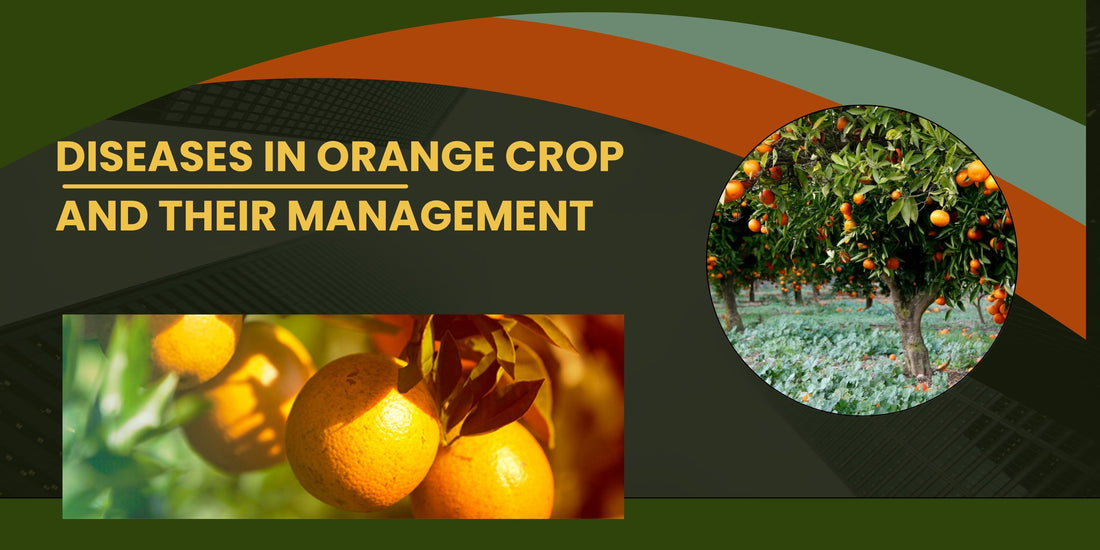
DISEASES AND PEST MANAGEMENT IN ORANGE
1.Citrus psyllid : Diaphorina citri
Symptoms of Damage:
- Both nymphs and adults suck sap from the plants and injection of toxic saliva.
- Nymphs - are more destructive, crowd on the terminal shoots, buds and tender leaves.
- Excrete honeydew growth of sooty moulds.
- Affected plant parts dry and die away.
- It is transmits the "Greening' virus.
Identification of pest:
- Nymphs- are flattened, oval in shape and scale like in appearance.
- Adult-minute insect, shiny black with grey dusting on the body.
- Wings are extending beyond the tip of the abdomen.
Management:
- Collect and destroy the damaged plant parts. Spraying with systemic insecticides at flush growth periods.
- Encourage the activities natural enemies such as Syrphids and Chrysopids.
2.Citrus leaf miner: Phyliccnistic citrella
Symptoms of damage:
- Caterpillars are attacked tender leaves and feed on the epidermis
- Making silvery appearance presence on the lower surface of leaves.
- Leaves - distorted and crinkled.
- Severe attack caused defoliation.
- Encourage the incidence of citrus canker.
Identification of pest:
- Eggs -are minute, flattened presence on the lower side of the midrib.
- Larvae-minute, yellowish or reddish and apodous.
- Settled down on the edge of the folded leaves.
- Adult-minute moth, black spot at the tip of the fore wing.
Management:
- mixed in a litre of water at weekly intervals at the time of emergence of new flush.
- Spray application of NSKE 5%.
3.Citrus butterfly: Papillo demotious, P. Polytes., Pheternus
Symptoms of damage:
- Caterpillars prefers on light green tender leaves.
- Feeding voraciously and leaving only the mid-ribs.
- Severe infestation the entire tree gets defoliated.
Identification of pest:
- Early stage larva resembles bird dropping.
- Grown up larva-cylindrical, stout, green and brown lateral bond.
- Adult-Dark brown swallowtail butterfly with numerous yellow marking.
Management:
- Hand pick the larvae and destroy
- Field release of parasitoids Trichogramme evanescens and lelenomus sp on eggs
- Brachymeria sp on larvae and Pterolus sp. on pupae.
Diseases:
1.Citrus Greening :
It is also called as huanglongbing that has been categorised as one of the obligate bacterial diseases with its causal organism scientifically known as Candidatus africanum and has been considered to be a key problem in majority of the citrus plantings. Minor insect pest particularly known as African citrus psyllid (Trioza ertreae) is primarily responsible for transmitting the disease while it feeds on the saps of phloem. Hence there is a high probability of transmitting this disease from infected trees to a healthy one with the help of the vector called citrus psyllid. Leaves of infected citrus trees shows a characteristic symptom of blotchy mottled in addition to yellow discolorations along with shrinking indicating narrowly structured with a bunchy appearance.
Control measures :
- (i) Disease free and healthy planting materials should be used for further elimination of this disease.
- (ii) Occurrence of the vector Diaphorina citri (Citrus psylla) should be kept under control for further preventing it from transmitting the disease.
2.Citrus Canker:
Citrus Canker is predominantly caused by the vector Xanthomonas citri pv. citri in which infested trees results in premature leaf and fruit drop, twig dieback, declination in fruit yield and blemished citrus. Symptoms include appearance of tiny blister like lesions in addition to distinct necrotic lesions with a raised corky appearance thereby leading to an occurrence of yellow halo. Infested fruits of citrus show symptoms of dark brown to black raised lesions. In addition, the diseased or the affected portions appear to be scabby or corky.
Control measures:
- Regular spraying of Streptocycline@100ppm by dissolving10g/100 litres of water and Copper sulphate@2 g/litre of water in the month of February,October and December throughout the year.
- Regular spraying of Bordeaux mixture three times at an interval of 30 dayswould help in eliminating the disease.
3.Gummosis:
Gummosis is particularly caused by the pathogen Phytophthora citrophthora which results in the formation of gum on the trunk and branches of citrus trees. Diseased portions of the trees show symptoms of vertical cracking of bark along with the formation and release of brown colored gum like substance from the lesions. In addition, it also shows symptoms of water soaked, reddish brown along with black slimy appearance on the affected bark of citrus trees. Severity of the infestation results in death of trees due to girdling of the bark by the pathogen. Due to the use of susceptible rootstocks along with the application of excessive irrigation water by the citrus growers, in addition to some abiotic factors including freeze damage, high water table and salt accumulation it leads to the rapid increase and development of the disease.
Control measures:
- (i) Collection of diseased leaves and fruits should be done on regular basis and buried deep down in the soil.
- (ii) Citrus growers should be encouraged to use tolerant and diseased free rootstocks.
- (iii) Excessive application of irrigation should be avoided.
- (iv) Trunk or bark of citrus trees should be painted with Bordeaux paint upto a height of 20 cm.
- (v) Diseased portions of the trunk or bark of trees should be regularly sprayed with Bordeaux mixture at a ratio of 2:2:250 three times in the month of February at pre-flowering stage, June and end of July.
- (vi) Application of Ridomil MZ in the form of paint at the affected portions of the trunk or bark and drench the soil with 25g/10 litre of water/tree at the base of the tree in the month of February to March and July to August in addition to spraying of Aliette 80 WP at the rate of 2.5g/litre of
- water in the month of April and September.
